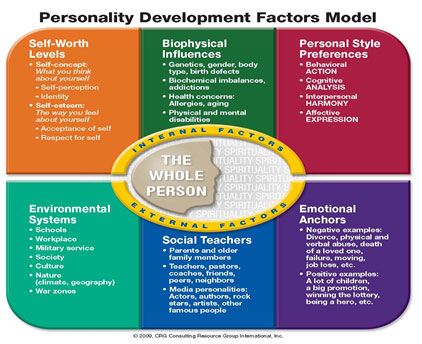The Preferences of Personal Style (Part Two)
By Ken Keis
This is the second of a seven-part series. Read Part One.
Personal Style defines naturally occurring preferences people have for engaging with whatever they find in their environment—their unique ways of reacting consistently to their surroundings. Their preferences are reflected in their various needs, wants, and values.
The origin of these preferences is unclear, but recent scientific research is offering some clues. Based on conclusions drawn from studies of the functions of various parts of the brain, Personal Styles may be closely related to different types of information-processing within the brain. Personal Style—or temperament, as some people like to call it—is observable very early after birth, suggesting that our preferences are genetically based.
If indeed Personal Style is natural, then it likely is strongly related to biochemical functioning in the brain. Understanding more about the brain’s biochemical development may reveal how Personal Styles are determined before birth. It should be noted, however, that the question of whether Personal Styles are inherited traits remains open; children often possess styles quite different from the styles of their parents and siblings can have opposite styles.
Some research attempts to link Personal Style to birth order, but that cannot easily account for certain discrepancies, such as why all first-born children don’t fit the same patterns.
We do know that children reveal a Personal Style that will remain unchanged throughout their lives; the style a person has at age 2 will be evident at age 80.
But let us be clear. We are stating that your Personal Style stays consistent throughout your lifetime; that is not necessarily true for your personality. Personality is the totality of who you are. Personal Style is just one part of you, but an important part, nevertheless.
We also know each individual tends to process information (think) in a distinct way. That means that although people see and hear the same information, they interpret the information differently. Those interpretations are called perceptions.
Let’s review.
- Personal Style is the part of your personality with which you are born and that does not change over time.
- Other parts of the personality do change, through learning and experience.
Those phenomena allow the personality to have both flexibility and stability throughout life.
Let’s suppose you attend your 10- or 20-year class reunion. You look around the room and see Harvey. He was the funniest guy in your class, not to mention the star player on the football team. But you hardly recognize him. You just can’t believe how much Harvey has changed. You go over and start talking with Harvey. Within 5 minutes, you realize there is something about him that hasn’t changed . . . his certain way of talking and being that makes you remember the two of you standing in the hallway 20 years ago. In spite of all the other changes, he’s the same old Harvey. The part that hasn’t changed is his Personal Style—all the Personal Style preferences within him.
Note: If you would like a chance to determine your Personal Style please go to www.crgleader.com and search for Personal Style Indicator and proceed from there.
Read Part Three.
Ken Keis is considered a global authority on the way assessment strategies increase and multiply your success rate. In 22 years, he has conducted more than 2000 presentations and 10,000 hours of consulting and coaching. Author of Why Aren’t You More Like Me? Discover the Secrets to Understanding Yourself and Others, Ken can be contacted at 604 852-0566, info@crgleader.com, or through www.whyarentyoumorelikeme.com.









